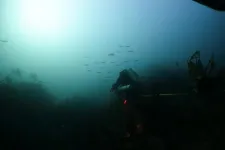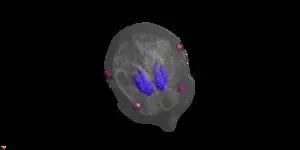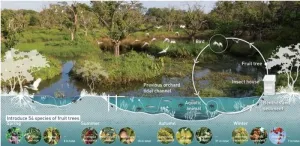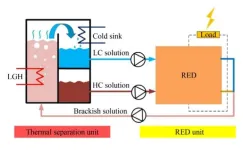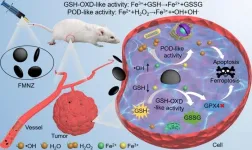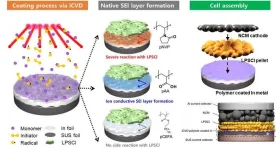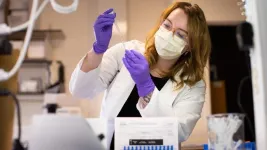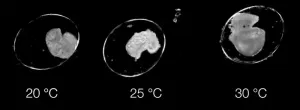(Press-News.org) 62% of Marine Protected Areas (MPAs) designated to protect rare migratory fish species are outside of their core habitats, according to a new modelling study. The findings are published in the British Ecological Society’s Journal of Applied Ecology.
A team of researchers in France from the “Pole MIAME” that gathers diadromous fish experts from multiple research institutions (OFB, INRAE, Institut Agro and UPPA) have developed a new modelling approach that accurately predicts core and unsuitable habitats of rare and data-poor diadromous fish (fish which migrate between marine and freshwater), such as threatened shads and the IUCN red-listed ‘critically endangered’ European eel.
The researchers found that 62% of MPAs which are specifically meant to protect diadromous fish species, don’t overlap with the core habitats of the fish modelled in the study.
In fact, only 55% of the modelled core habitats of diadromous fish fell within any MPAs, and of these protected areas, only had half had specific measures to protect the species.
When looking at individual species, the researchers found that less than 30% of the endangered Mediterranean twaite shad (Alosa agone) core habitat was within MPAs.
Although other species such as European eel and European smelt had around 70% of their core habitats within MPAs, only 9% of these MPAs have specific measures to protect the European eel, and none had specific measures to protect European smelt.
Dr Sophie Elliott at the Game and Wildlife Conservation Trust (previously at Institute Agro in France) and lead author of the study, said “Given the sharp decline in diadromous fish which was noted just last week by The Living Planet Index (LPI) for migratory freshwater fishes 2024 update, it is a surprise more isn't being done to protect these species.
“We found that existing Marine Protected Areas with and without measures to protect listed diadromous fish across France, England, Belgium, and the Netherlands are not adequately protecting them despite a number of these fish being protected.”
Dr Anthony Acou, at the French Biodiversity Agency and Patrinat, in charge of diadromous fish evaluation for the EU MSFD (Marine Strategy Framework Directive), and a co-author of the study, added that “Due to a lack of data on rare species, spatial protective measures are often implemented with little understanding of the species distribution and habitat (‘the rare species paradox’).”
Dr Laurent Beaulaton, also at the French Biodiversity Agency, and a co-author said “We hope that our ‘Combined Model for Accurate Prediction’ methodological framework can help improve accurate rare species distribution modelling for reliable biodiversity assessments, meaning conservation measures can be targeted in specific areas that protect rare and poorly detected species while also minimising conservation impacts on human activity.”
The researchers tested their newly developed modelling approach on diadromous fish because very little is known about their at-sea life history stage and there is no existing model of their distribution.
These types of fish are also sensitive to anthropogenic pressures. Dr Sophie Elliott explained that “Diadromous fish species are particularly threatened because they are subject to terrestrial, freshwater, and marine pressures such as agricultural and pollutant runoffs, habitat destruction, barriers to migration, fishing, bycatch, and climate change. These barriers cumulate through their life cycle as they travel between their freshwater and marine habitats.”
To test the accuracy of their new modelling approach, the researchers collated an unprecedented amount of data on fisheries-dependent and independent data within eastern Atlantic and Mediterranean waters, focussing on 11 rare and data-poor diadromous fish including the European eel, European flounder, smelt and three species of shad and the thinlip mullet. They then compared the predicted core and unsuitable habitats for the fish against 89 OSPAR and habitat Directive MPAs found in these waters.
The researchers would now like to see their modelling approach expanded to larger areas across the Northeast Atlantic and look closer at habitat types. “The next step is to better characterise at-sea functional habitats (migratory corridor, nursery area, refuge area) of the different species. But for that additional data are needed…” added Dr Etienne Rivot, a population modelling expert at DECOD (Ecosystem Dynamics and Sustainability), L’Institut Agro, INRAE, Ifremer, and a co-author of the study.
The researchers also highlight that the modelling approach could be used for other protected, threatened and usually rare species, particularly for species where protected areas have been put in place for their conservation.
- Ends -
END
The advancement of urbanization and globalization has impacted every corner of the Earth, human activities have transformed over one-third of the planet’s ecosystems, including agricultural lands and urban areas. Thus, there is an urgent need to define and achieve the equilibrium of novel ecosystems.
This study employed pragmatic designed experiments as its core method, integrating methodologies from empiricism, positivism, and romanticism to propose a semi-empirical ecological design framework that emphasizes learning by doing and research through practice. ...
A new study by Chinese scientists, released on May 29 in Shanghai, has called for the use of consumption-based accounting (“CBA”) emissions in calculating global carbon emissions in order to help make allocating responsibility for reducing emissions just and fair.
The study, “Research Report on Consumption-based Carbon Emissions (2024)” (“the Report”), was jointly completed by scientists from several institutes under the Chinese Academy of Sciences (CAS) as well as from Tsinghua University.
The ...
The depletion of energy resources poses a significant threat to the development of human society. Specifically, a considerable amount of low-grade heat (LGH), typically below 100 °C, is currently being wasted. However, if harnessed effectively, it has the potential to significantly improve overall energy utilization efficiency and subsequently reduce carbon dioxide emissions.
A research group of Junyong Hu from Taiyuan University of Technology has concentrated on developing a new type of reverse electrodialysis ...
The Colorado River is a lifeline for many cities and farms in the Southwest United States. It flows for about 1,448 miles before reaching the Gulf of California in Mexico and supplies water to numerous cities and farms along the way.
However, over the past 60 years, the amount of water in the Colorado River has been shrinking. In fact, in some years, the river’s water has been used up completely before it reaches the gulf.
Landon Marston, assistant professor in civil and environmental engineering, teamed up with researchers from multiple universities and ...
According to a recent study published in Chemical Engineering Journal, a collaborative research team led by Professor WANG Hui from High Magnetic Field Laboratory, Hefei Institutes of Science of Chinese Academy of Sciences developed magnetite nanozyme (MNZs) with dual enzymatic activities through structural engineering, and proved its structure-dependent behavior in the process of tumor treatment.
MNZs, as a substitute for natural enzymes, has been widely studied in the field of tumor catalytic therapy. However, the catalytic efficiency of traditional MNZs in tumor microenvironment (TME) is often limited, which is mainly due to the low production rate of hydroxyl radical ...
People have various relationships in society including those with family, friends, and coworkers. While these relationships play a significant role in our lives, it's crucial to maintain a healthy distance as being too close can lead to intense emotions or conflicts. Interestingly, a recent study in the field of chemistry demonstrates that maintaining such distance can enhance battery performance in electric vehicles.
In this research, Professor Soojin Park, Dr. Sungjin Cho and Youngjin Song, a PhD student, from the Department of Chemistry at Pohang University of Science and Technology (POSTECH) in collaboration with the team of Professor Sung Gap Im ...
May 28, 2024
For more information, contact:
Nicole Fawcett, nfawcett@umich.edu
EMBARGOED for release at 6:30 p.m. ET May 28, 2024
Altering cancer treatment dosing could reduce climate impact, study finds
Model estimates potential to reduce greenhouse gas emissions by delivering treatment every 6 weeks
ANN ARBOR, Michigan — Changing how often a popular cancer therapy is delivered would reduce greenhouse gas emissions and improve environmental impact without decreasing cancer survival, according to a new analysis from researchers at the University of Michigan Health Rogel ...
Corals play an essential role in ocean ecosystems, and like many organisms, they are under threat from climate change and other human activities. To better protect coral, it’s first necessary to understand them, in particular their reproductive life cycle, which only happens once a year. For the first time, researchers have produced a model for coral spawning, based on various environmental factors. They achieved this by tapping an often overlooked source of aquatic knowledge, an aquarium.
Given their branching shapes or waving tendrils, you would be ...
Research led by the University of Plymouth has shown that a new deep learning AI model can identify what happens and when during embryonic development, from video.
Published today (Wednesday 29 May) in the Journal of Experimental Biology, the study highlights how the model, known as Dev-ResNet, can identify the occurrence of key functional developmental events in pond snails, including heart function, crawling, hatching and even death.
A key innovation in this study is the use of a 3D model that uses changes occurring between frames of the video, and enables the AI to learn from these features, as opposed to the more traditional use of still images.
The ...
Primates, including humans, have larger brains than most other mammals, but why? Scientists searching for the answer have long followed a trail pointing to diet—specifically fruit—as the reason for why primates evolved larger brains. A team from the Max Planck Institute of Animal Behavior and the Smithsonian Institute of Tropical Research tested this idea for the first time—finding that the fruit-diet theory might be out of juice. The researchers used drone imaging, GPS tracking, and fine-scale behavioral analyses to test how four species of fruit-eating mammals solved the same natural foraging puzzle in a Panamanian rainforest. They ...
